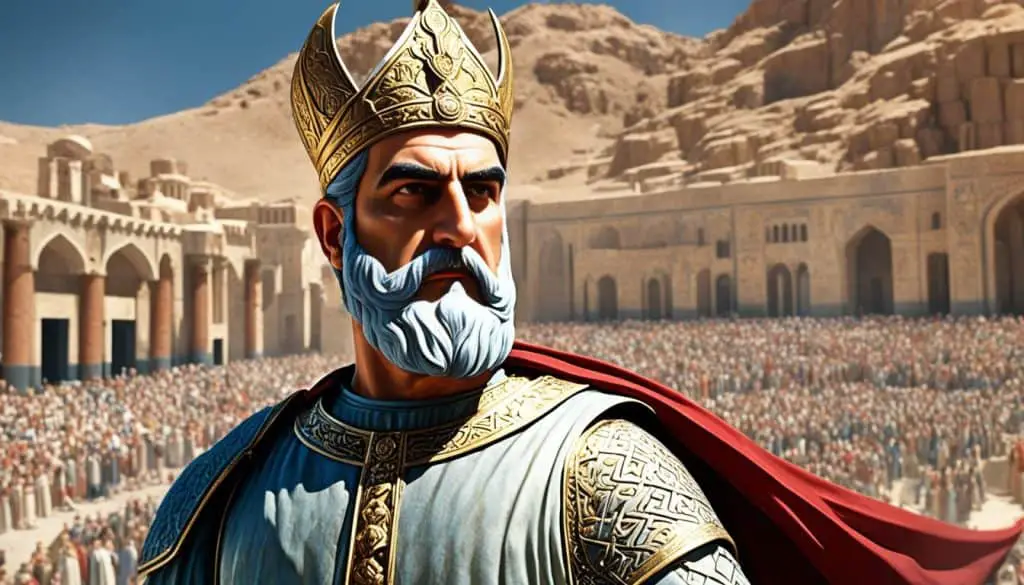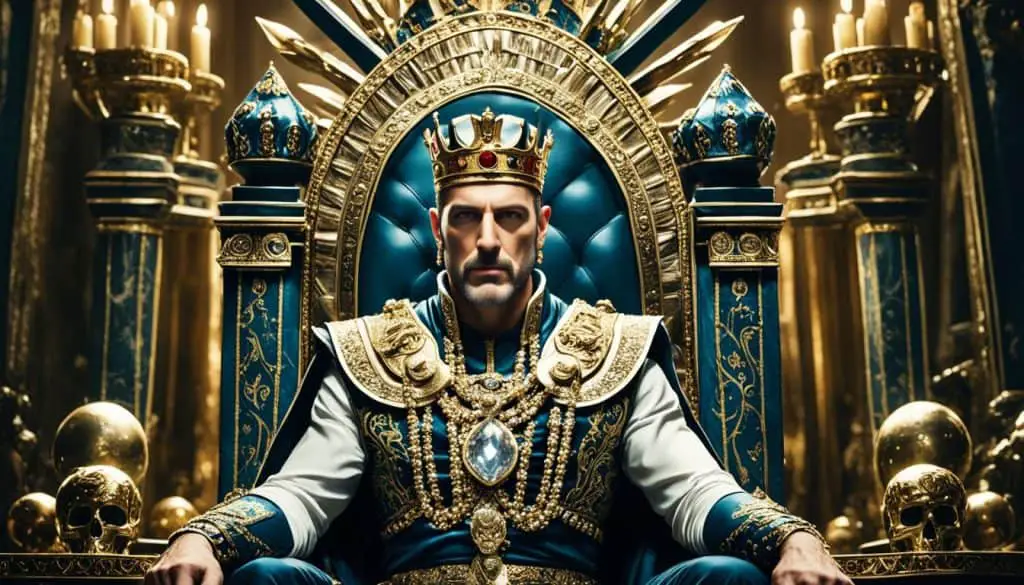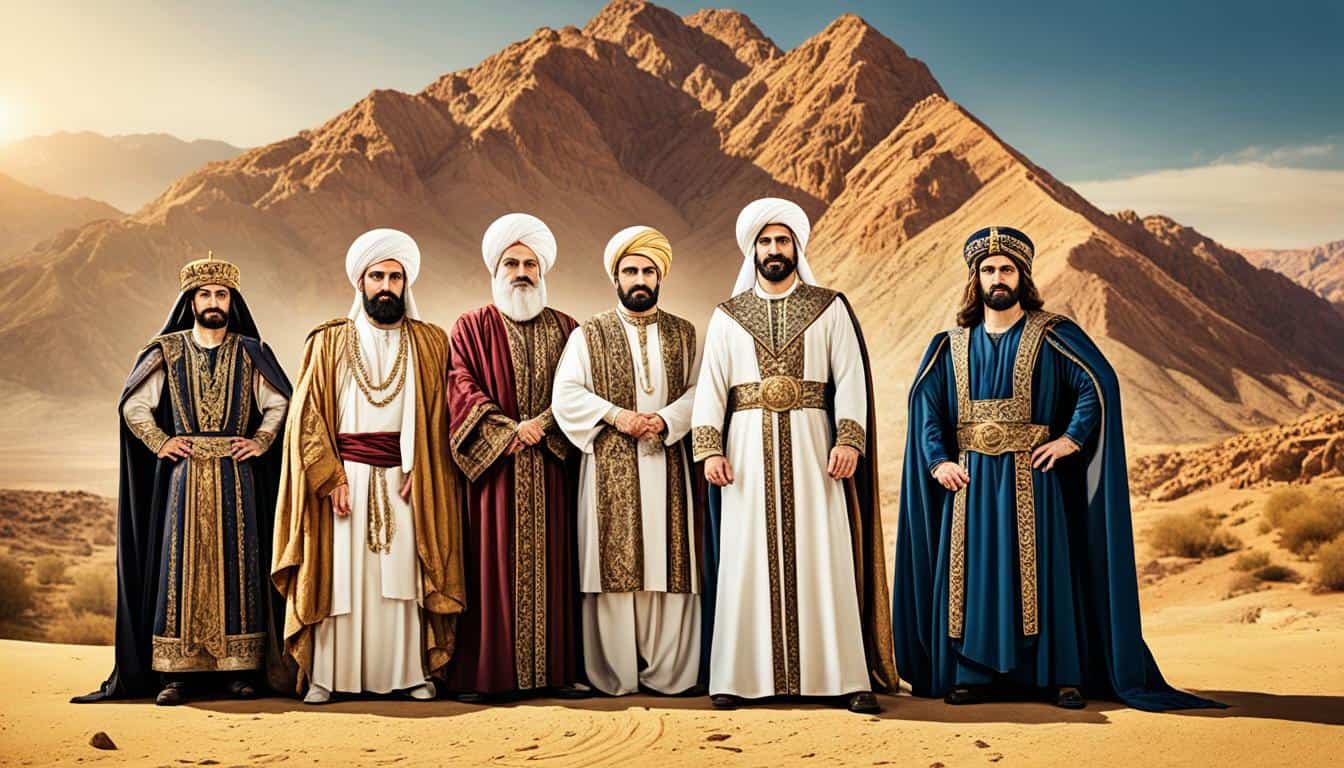Table of Contents
Have you ever thought about the Persian rulers mentioned in the Bible? Five leaders stand out in the biblical world. They changed history with their power, mystery, and huge impact.
Discover the stories of these Persian rulers. Each one, from Cyrus the Great to Artaxerxes I, left a special mark on history and the Bible. Learn how these leaders affected religion, nations, and their people’s future.
Come with us on a journey back in time. Explore the lives of Persian rulers in the Bible. Their tales will make you think, spark your interest, and show you more about ancient history’s big names.
Cyrus the Great (Ezra 1:1-4, 6:3-5)
Cyrus the Great is a key figure in Persian history and the Bible. He founded the Achaemenid Empire. In 539 BC, he conquered Babylon. This major victory boosted his rule and his historical status.
In the Bible, Cyrus’ capture of Babylon is seen as a positive event. It shows his strong leadership and military skills. This win not only ended Babylon’s rule but also led to a decree benefiting the Israelites.
After Babylon, Cyrus gave the Israelites hope with a decree. The decree, in the Book of Ezra (1:1-4, 6:3-5), allowed them to go back to Jerusalem. There, they could rebuild their temple.
Moreover, Cyrus’ decree supported the temple’s reconstruction. He showed kindness and acceptance of different beliefs. This highlights his wisdom and a tolerant view of religion and culture.
Cyrus’ decree was a huge moment for the Israelites. It helped restore their cultural and religious life. Its impact was deeply significant and long-lasting.
| Cyrus the Great | Key Points |
|---|---|
| Founder of the Achaemenid Empire | Established a powerful empire in ancient history |
| Conqueror of Babylon | Defeated the Babylonian empire in 539 BC |
| Decree Allowing Israelites to Return | Issued a decree for the Israelites to return to Jerusalem and rebuild their temple |
| Religious Tolerance | Demonstrated a respect for different cultures and religions through his decree |
Darius the Mede (Daniel 5:31, 6:1, 9:1)
In the book of Daniel, we meet Darius the Mede. He took over Babylon after the Medes and Persians conquered it. There’s some debate about whether he actually existed. But, according to the Bible, Darius was respectful towards Daniel. He even gave him an important job.
This part of ancient history is fascinating. It shows how Darius the Mede, despite challenges, valued Daniel’s wisdom. Darius trusted Daniel with a top government role. This offers a glimpse into Darius’s leadership and his relationship with Daniel.
“And Darius the Mede received the kingdom, being about threescore and two years old.” – Daniel 5:31
After Babylon’s fall, Darius the Mede took the throne. This was a big change in the area’s politics.
Some still question if Darius the Mede was real. But, the Bible’s story focuses on Daniel. Darius seemed to really like Daniel because of his faith and wisdom. He gave Daniel an important role because of this.
This story tells us about the complex world back then. We see how respect and integrity mattered in high power.

Exploring Darius the Mede’s life and times is both interesting and revealing. His story is full of historical and biblical importance. It shows the link between power, faith, and leadership.
Significance of Darius the Mede
We’re still not sure if Darius the Mede truly ruled. But his image in the Bible highlights his respect for Daniel. This is very important. It shows us qualities of leadership and the mix of politics and faith. It also highlights the value of respect and good character in leadership roles.
| Key Details | Implications |
|---|---|
| Throne of Babylon | Darius the Mede’s rise to power after Babylon’s fall was a big deal. It showed the Medes and Persians were now in control. |
| Respect for Daniel | Darius’s high opinion of Daniel’s skills, faith, and loyalty was key. It meant character and honesty were very important in Darius’s kingdom. |
| High Position for Daniel | By giving Daniel a top job, Darius showed he valued real talent. He looked past where someone was from to see their abilities. |
The story of Darius the Mede makes us think about good leadership skills, the mix of politics and faith, and the continued value of respect and honesty in powerful positions.
Ahasuerus (Xerxes I) (Esther 1:1-2)
The book of Esther tells the story of Ahasuerus. This is the Hebrew name for the Persian king Xerxes I. He ruled from 486 to 465 BC. Ahasuerus is an important character in the tale of Esther, a young Jewish woman who saves her people from being killed.
Ahasuerus controlled 127 provinces in the ancient Persian Empire. This rule covered lands from India to Ethiopia. He was known for throwing big banquets and living a very luxurious life. This let him show off his wealth and power to everyone, including the nobles.
Esther, a Jewish woman, grabbed the king’s attention, and soon she became queen. What Ahasuerus didn’t know is that Esther was hiding a secret – she was Jewish. When Haman, one of the king’s top advisors, planned to kill all the Jews, Esther knew she had to act. She revealed her true background and stopped the plan to kill her people.
“Who knows whether you have come to the kingdom for such a time as this?” – Esther 4:14
Esther showed outstanding courage and determination. She put her own life at risk to save her fellow Jews. With her cousin Mordecai’s help, they managed to show Haman’s true intentions. They also persuaded Ahasuerus to change his mind about killing the Jewish people.
The story of Ahasuerus and Esther is about bravery, faith, and overcoming tough times. It teaches us that one person’s actions can really change things, even when facing a great danger.
Take a dive into the captivating story of Ahasuerus and Esther. It’s a story where faith and loyalty win over evil. These acts leave a lasting impact on history and people’s hearts.
Key Takeaways:
- Ahasuerus, also known as Persian King Xerxes I, ruled over the vast Persian Empire from 486-465 BC.
- Esther, a Jewish queen, played a pivotal role in stopping a genocidal plot against her people.
- The bravery and resilience of Esther serve as an inspiration to generations, showcasing the power of one person’s actions in the face of adversity.
Artaxerxes I (Ezra 7:1-7, Nehemiah 2:1-8)
From 465 to 424 BC, Artaxerxes I ruled the Persian Empire. He is well-known for his role in Jewish history, found in books by Ezra and Nehemiah. Artaxerxes asked a priest and writer, Ezra, to go back to Jerusalem. There, Ezra worked to fix religious life after years of exile.
Ezra focused on restoring Jewish customs, teaching the Torah, and bringing back the Levites. Thanks to Artaxerxes, Ezra had the power to set laws and protect the Jews’ faith. This effort helped the people spiritually and morally.

Artaxerxes also gave Nehemiah, a high-ranking official, permission to repair Jerusalem’s walls. This was vital for the city’s safety and defense.
“And the king said to me, ‘Why is your face sad, seeing you are not sick? This is nothing but sadness of the heart.’ Then I was very much afraid. I said to the king, ‘Let the king live forever! Why should not my face be sad, when the city, the place of my fathers’ graves, lies in ruins, and its gates have been destroyed by fire?'”
Nehemiah 2:2-3
When Nehemiah spoke up, Artaxerxes noticed. The king then supported Nehemiah’s project to rebuild the walls. Despite many challenges, Nehemiah succeeded in fortifying Jerusalem. This strengthened the city and the Jewish people’s sense of unity.
Impact on the Jewish People
The actions of Artaxerxes, along with Ezra’s and Nehemiah’s work, changed the Jewish people’s lives. Thanks to Ezra, their religious life was revived, which united the community. Nehemiah’s wall facedown restored safety and togetherness among the people.
| Impact of Artaxerxes’ Decisions | Ezra’s Commission | Nehemiah’s Permission |
|---|---|---|
| Revival of religious practices | Reestablishment of Jewish rituals and the study of the Torah | Restoration of Jerusalem’s walls for increased security |
| Reinforcement of the Levitical priesthood | Appointment of judges and enforcement of Jewish law | Preservation of the city’s autonomy and identity |
| Strengthening of the Jewish community | Fostering a renewed sense of identity | Provision of security and unity |
Artaxerxes’ choices were key for the Jewish people. They helped rebuild the city and their faith. Ezra and Nehemiah played important roles under Artaxerxes’ reign. They guarded tradition and the people’s homeland.
Cambyses II (Ezra 4:6)
In the book of Ezra, Cambyses II is mentioned briefly. He was the son of Cyrus the Great and ruled from 530-522 BC. As the heir to his powerful father, Cambyses II dealt with challenges. These issues affected the Jewish people.
While ruling, the Jewish faced many problems. Partly, these were due to political issues after Cyrus’s death. Cambyses II’s attitude towards the Jews also worsened. This led to more problems for them.
The Bible doesn’t fully detail the struggles the Jews faced under Cambyses II. However, we know they encountered many difficulties. Learning about Cambyses II’s time helps us see the hardships the Jewish community went through then.




